Understanding Shipping Labels and Placards for Radioactive Materials
- Regulations about Shipping Radioactive Materials
- Types of Packages
- Nomenclature
- How Much Radioactivity is in a Package?
- Package Markings
- Labels
- Placards
- More about UN ID numbers
- Limits on Amount of Radioactivity for Shipping
- Selected References
Regulations about Shipping Radioactive Materials
- Transport of hazardous materials including radioactive material in the US is regulated by multiple federal, state, and local agencies.
- The key U.S. agencies include the U.S. Nuclear Regulatory Commission (NRC) and the U.S. Department of Transportation (DOT).
- The areas regulated include the packaging, contents, radiation levels, and various transport requirements, including labeling and shipping papers.
- Before transport, shippers of radioactive material are required to check the radiation levels of packages to ensure that all levels are within allowed limits.
- Radiation levels are checked
- On the packaging surface AND
- At one meter (3.3 feet) from the package.
- Radiation levels are checked
- Detailed regulatory information about these complex regulations and laws
- Transporting Hazardous Materials (OSHA web site aggregating information from many sources)
- Electronic Code of Federal Regulations: Title 49 -Transportation: 49 CFR
Types of Packages
- There are 4 types of packages for radioactive material that are commonly used in the US. Each has its own detailed regulations.
- Excepted packages: extremely low levels of radioactivity with very low hazard.
- Excepted packagings are authorized for limited quantities of radioactive material that would pose a very low hazard if released in an accident.
- Examples of material typically shipped in excepted packaging include consumer goods such as smoke detectors.
- Excepted packagings are excepted (excluded) from specific packaging, labeling, and shipping paper requirements; they are however, required to have the letters “UN” and the appropriate four-digit UN identification number marked on the outside of the package.
- Requirements for excepted packaging are addressed in 49 CFR 173.421.
- See photo of Excepted package below
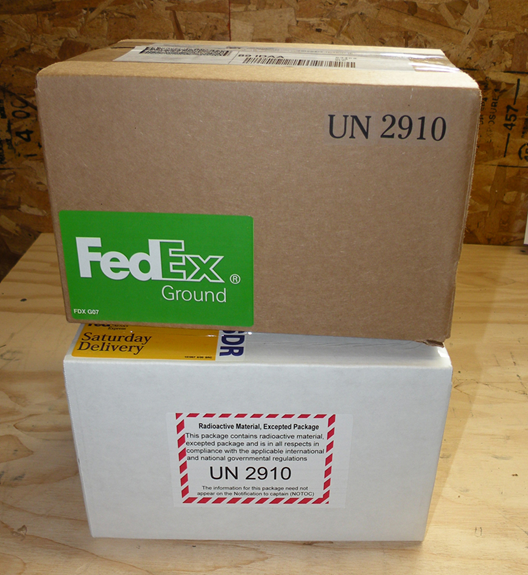
Example of Radioactive Excepted Package (Source DOT/TEPP/MERRTT)
Label reads “Radioactive Material Excepted Package. This package contains radioactive material, excepted package and is in all respects in compliance with the applicable international and national governmental regulations. UN 2910
(Note: 2910 means Radioactive material, excepted package-limited quantity of material.)
- Industrial packages: low levels of radioactivity with very low hazard; used in certain shipments of low activity material and contaminated objects, which are usually categorized as radioactive waste.
- Most low-level radioactive waste is shipped in these packages.
- Department of Transportation (DOT) regulations require that these packages allow no identifiable release of the material to the environment during normal transportation and handling.
- There are three categories of industrial packages: IP-1, IP- 2, and IP-3.
- The category of package will be marked on the exterior of the package.
- Requirements for industrial packaging are addressed in these regulations: 49 CFR 173.411.
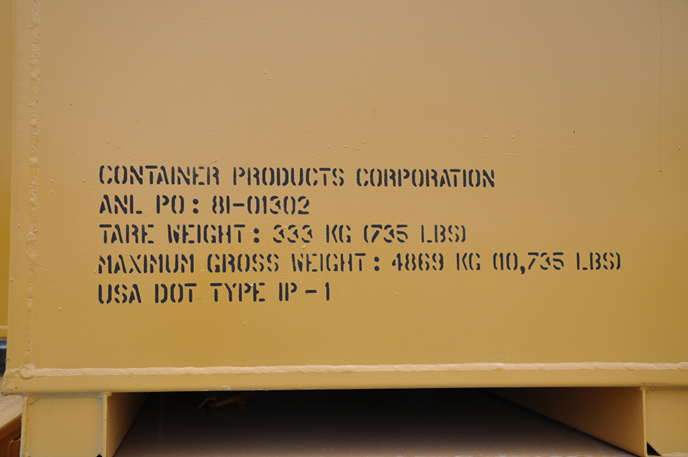
Example of Industrial Package Type IP-1 (US DOT Type IP-1 (Source of graphic above: DOE/TEPP/MERRT)
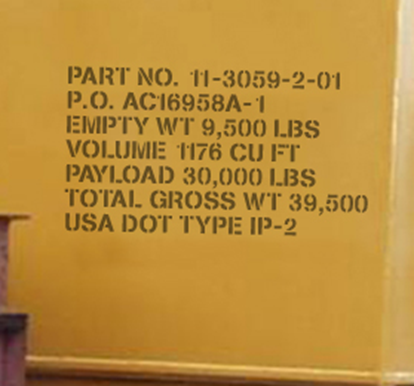
Example of Industrial Package Type 2 (US DOT Type IP-2 (Source of graphic above: DOE/TEPP/MERRT)
- Type A packages: used to transport small quantities of radioactive material with higher concentrations of radioactivity than those shipped in industrial packaging
- They are typically constructed of steel, wood, or fiberboard, and have an inner containment vessel made of glass, plastic, or metal surrounded with packing material made of polyethylene, rubber, or vermiculite.
- Examples of material typically shipped in Type A Packages include nuclear medicines (radiopharmaceuticals), radioactive waste, and radioactive sources used in industrial applications.
- Type A packaging and its radioactive contents must meet standard testing requirements designed to ensure that the package retains its containment integrity and shielding under normal transport conditions.
- Requirements for Type A packaging are addressed in 49 CFR 173.412
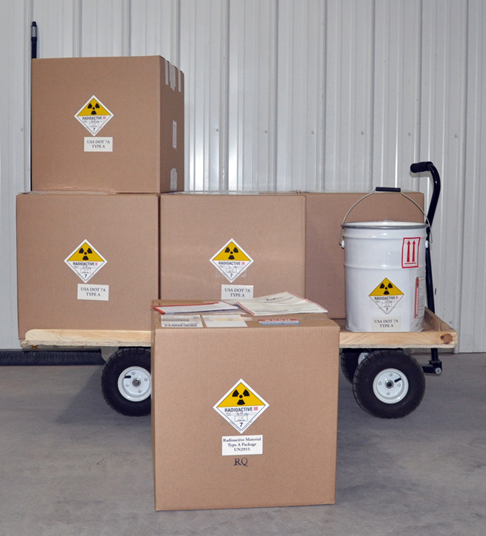
Example of Type A package (Source of graphic above DOE/TEPP/MERRT)
Information on labels above
- The cardboard package in the foreground above has a Radioactive Yellow-III hazard label (square on point) AND a separate black text on white marking which says “Radioactive Material Type A Package, UN 2915.
- UN 2915 means “Radioactive material, Type A package [non-special form, non fissile or fissile-excepted”)
- RQ, printed below the UN ID, means “reportable quantity”.
- Type B packages: designed to transport material with the highest levels of radioactivity
- Designed to survive severe accidents conditions (e.g., impact, fire, water immersion)
- Designed to transport material with the highest levels of radioactivity
- Type B packagings range from small hand-held radiography cameras to heavily shielded steel casks that weigh up to 125 tons. (See photos below.)
- Life-endangering amounts of radioactive material are required to be transported in Type B Packages.
- Examples of material transported in Type B packagings include spent nuclear fuel, high-level radioactive waste, and high concentrations of other radioactive material such as cesium and cobalt.
- These package designs must withstand all Type A tests, AND a series of tests that simulate severe or “worst-case” accident conditions.
- See video explaining tests: Radioactive Material Shipping Packages (YouTube - 5:48 minutes) (DOE/TEPP/MERRTT)

- Accident conditions are simulated by performance testing and engineering analysis.
- See video explaining tests: Radioactive Material Shipping Packages (YouTube - 5:48 minutes) (DOE/TEPP/MERRTT)
- Requirements for Type B packaging are addressed in the following regulations 49 CFR 173.411, 49 CFR 173.413, and 10 CFR 71.
- Type B package can have designations “(U)” or “(M)” (e.g., Type B (U) or Type B (M))
- U = Unilateral: the package design is approved by the country of origin.
- M = Multilateral: the package design is approved by each country through or into which the package is to be transported.
- Examples of Type B packages are shown below
- Blue cask seen below on this page
- Radiography camera below
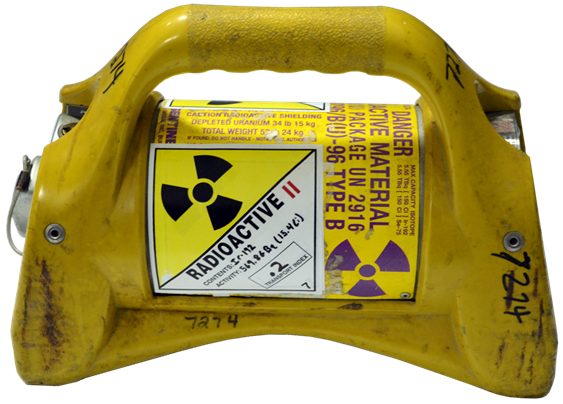
Example of Type B package: Radiography Camera (Source of graphic above: DOE/TEPP/MERRTT)
Note: information on the radiography camera label includes
- Label type: Radioactive Yellow-II
- Contents: Iridium-192
- Activity 569.8 GBq (15.4 Ci)
- Transport Index: 0.2
- UN Hazard (DOT) 7: radioactive material
- Type B(U): type B package, Unilateral
- UN ID 2916: (Radioactive material, Type B(U) package [non fissile or fissile-excepted)
- Caution: RADIOACTIVE SHIELDING, DEPELETED URANIUM 34 lb15 kg, TOTAL WEIGHT 52.91lb. 24 kg
- The following documents provide more details about package types with videos, and pictures
- Radioactive Material Shipping Packages (YouTube - 5:48) (DOE/TEPP/MERRTT)

This excellent video shows various kinds of packages and how package strength is tested. - Transportation Emergency Preparedness Program/Emergency Responder Radioactive Material Quick Reference Sheet (PDF - 461 KB) (DOE/TEPP)
- Radioactive Materials, Transportation and Incident Response (PDF - 8 MB) (FEMA, DOE/TEPP, May 2010)
- Transportation of Radioactive Materials, (PDF - 371 KB) (Reactor Concepts Manual, USNRC Technical Training Center, Chapter 11. This is an older document, but it has useful background material.)
- Radioactive Material Shipping Packages Teaching Module (PDF - 2.13 MB) (DOE/TEPP/MERRTT)
- Radioactive Material Shipping Packages (YouTube - 5:48) (DOE/TEPP/MERRTT)
- Excepted packages: extremely low levels of radioactivity with very low hazard.
Nomenclature
- Vehicles contain packages. Examples of vehicles include trucks and rail cars. Trucks can be exclusive use or non-exclusive use. Trucks can be closed or open.
- Packages are the outer containers used to ship radioactive and other types of hazardous materials. There are various kinds/strengths of regulated packages. Package material and construction is regulated to insure that package safety is adequate to protect the contents from disseminating, even if there is an accident. As the amount of radioactivity being transported increases, the regulated strength of the packaging increases accordingly.
- Labels are standardized paper hazmat identifiers, designed to meet certain specifications, and placed on 2 sides of packages, packagings, or overpacks. Labels indicate what kind and how much radioactive material is inside the package.
- Placards are more durable standard hazmat identifiers, designed to meet certain specifications, and placed on outer containers, trucks, cylinders, or other vehicles used for transport. These are not made of paper.
- Markings are additional identifiers (other than hazard labels & placards) that further describe the package contents.
- Radioactive material for transportation purposes means any material having a specific activity greater than 0.002 microcuries per gram (µCi/g).
- The specific activity of a radionuclide means the activity of the radionuclide per unit mass of that nuclide.
How Much Radioactivity is in a Package?
- The size or weight of a package does not indicate how much radioactivity is in the package or shipment.
- The amount of radioactivity in a package or container can be determined by noting how many becquerels or curies of the material are present.
- More becquerels or curies means a greater amount of radioactivity.
- This information can be found on package labels and shipping papers.
- There is no direct correlation to the physical size of a material and the level of radioactivity.
- A large amount of material can have a very small amount of radioactivity; a very small amount of material can have a lot of radioactivity.
- For example, uranium-238 has 0.00015 curies of radioactivity per pound (150 microcuries), while cobalt-60 has over 500,000 curies per pound.
Package Markings
- Package markings are designed to inform transportation workers and emergency response personnel about the package’s radioactive contents.
- Markings may be printed directly on a cardboard container or attached via printed shipment specific label to more robust containers.
- Some of the markings on a radioactive material package include the following:
- Proper Shipping Name, Package type, and UN identification number (e.g., Radioactive material, Type A package, UN 2915)
- “Radioactive LSA” (low specific activity) or “Radioactive SCO”1 (surface contaminated objects) (if applicable)
- Gross weight, if package weighs more than 110 lbs
- Orientation arrows to show which side should be “up”. This is a good indication that the package contains liquids (see figure below)
- “RQ” if the package contains a reportable quantity of material.
- Emergency contact information, if required
- These text markings are NOT the same as the paper standardized warning labels affixed to opposite sides of the outer package.
- Examples packages and package markings are shown below
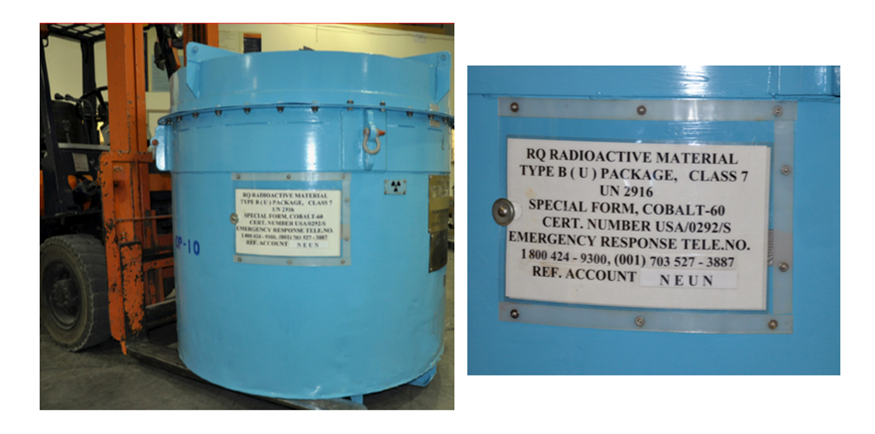
Package marking on Type B package (blue cask) (Source of photos above: Radioactive Materials, Transportation and Incident Response, (PDF - 8 MB) FEMA, DOE/TEPP, May 2010)
Information on label includes:
- Radioactive Material
- RQ: reportable quantity
- Type B: package type
- (U) package: Unilateral means the package design is approved by the country of origin.
- Contents: Special Form, Cobalt-60
- Class 7 = radioactive material
- UN 2916 = Radioactive material Type B(U) package [non fissile or fissile-excepted]
- Emergency Response Telephone No.
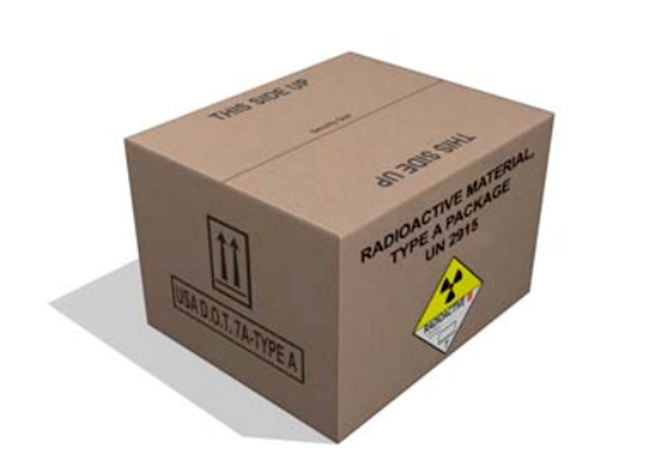
Package Markings Type A package. (Source of photo above: DOE/TEPP/MERRTT Training Course: Hazard Recognition, (PDF - 705 KB))
Package markings on Type A package above include- Radioactive Material
- Type A package
- UN number 2915: Radioactive material, Type A package [non-special form, non fissile or fissile-excepted)
- USA DOT (UN ID): 7, indicating radioactive material
- Up arrows indicated the top side of the package
Labels
- Examples of 5 different types of paper labels are shown in the graphic below with the explanation when they are used.
- They are used only on packages containing (or formerly containing) radioactive materials.
- Standard paper label size is about 4 inches by 4 inches and is displayed “on point”.
- Labels are NOT the same as markings or placards
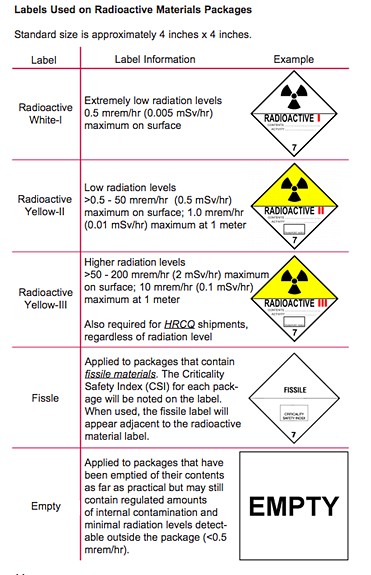
Examples of the 5 required Hazard Labels for Shipments of Radioactive Material. (Source of graphic above: Radioactive Materials, Transportation and Incident Response (PDF - 8 MB) (FEMA, DOE/TEPP, May 2010, page 14)
- Where are hazard labels placed for shipping?
- The standard labels are placed on opposite sides of the package
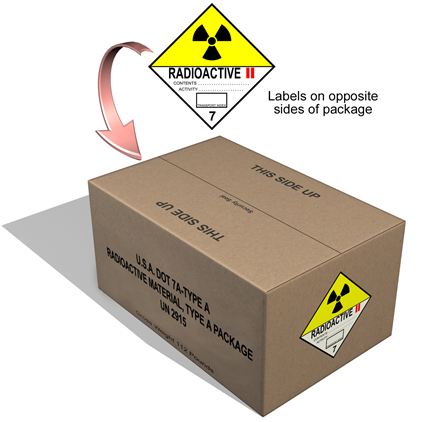
Where Hazard Labels are Placed on Type A package. (Source of graphic above: DOE/TEPP/MERRTT training course: Hazard Recognition) (PDF - 705 KB)
- The standard labels are placed on opposite sides of the package
- Explaining shipping labels
- All shipments of radioactive material, with the exception of those containing very small quantities of radioactive material or those of low specific activity (LSA) or surface contaminated objects (SCO), will have markings on the outside of the package that give key information about the package.
- When required, labels must be applied to opposite sides of the package
- Labels include the following information
- Label types (N = 5): Radioactive White-I, Radioactive Yellow-II, Radioactive Yellow-III, Fissile, Empty
- Radioactivity trefoil appears on the first 3 label types listed above
- A yellow background appears under the trefoil for only these labels
- Radioactive Yellow-II
- Radioactive Yellow-III
- A yellow background appears under the trefoil for only these labels
- Contents: radioactive isotope (e.g., Cs-137, Ir-192, etc.)
- This information is listed only on Radioactive I, II, and III labels.
- Activity: activity level in becquerels (Bq) or curies (Ci).
- This information is listed only on Radioactive I, II, and III labels.
- Transport index (TI)
- Transport index is located in the black bordered rectangular box just above the radiation Class number “7”.
- The transport index is determined by the shipper that helps provide control over radiation exposure and establish transport controls.
- Only Radioactive Yellow-II and Radioactive Yellow-III labels must show the transport index.
- Radioactive Yellow-II label can be used for up to 1.0 mrem/hr @1 meter.
- The transport index is determined by taking the maximum radiation level (as measured in mrem/hr) at one meter (3.3 feet) from an undamaged package. See photo below.
- When assessing a package’s integrity at an accident scene, this information can be used as a baseline for determining if damage has occurred to the package
- For example, a TI of 0.2 would indicate that, at 1 meter from the labeled package, the radiation dose rate should be no more than 0.2 mrem/hr (0.002 mSv/hr).
- CAUTION: Be aware that other radioactive material packages in the immediate vicinity may interfere with measurements, resulting in radiation levels above the indicated transport index of any particular package.
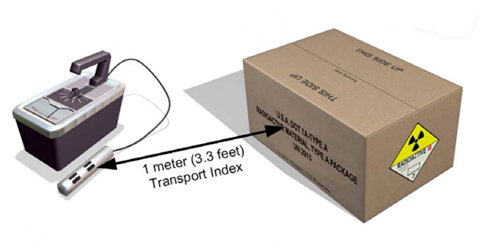
Explanation of Transport Index (TI) (Source of graphic above: Assessing Package Integrity (PDF - 557 KB) (DOE/TEPP/MERRTT training course: Hazard Recognition)
- Transport index is located in the black bordered rectangular box just above the radiation Class number “7”.
- Criticality Safety Index number: must be shown on Fissile labels only.
- Single digit “UN Hazard Identifier” (United Nations)
- Not found on “EMPTY” labels.
- There are nine “Classes of Hazards”
- “Radioactive Material” is Class 7
- This is represented by the number “7” at the bottom corner of the 4-sided label or placard.
- NA numbers (North America), also known as DOT numbers are issued by the United States Department of Transportation and are identical to UN numbers, except that some substances without a UN number may have an NA number. These additional NA numbers use the range NA8000 - NA9999.
- See list of 9 hazard classes.
- Following the UN Model, the US DOT divides regulated hazardous materials into nine classes, some of which are further subdivided.
- If a substance poses several dangers, then subsidiary risk identifiers may be specified.
- It is not possible to deduce the hazard class(es) of a substance from its 4 digit UN number.
- One hypothetical example of a Radioactive Yellow-II package label is shown below.
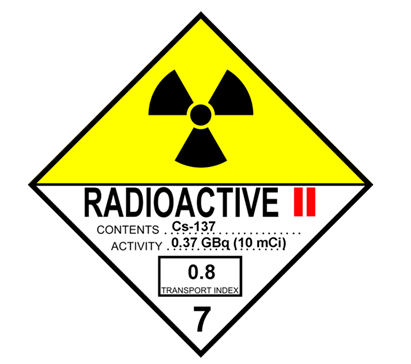
- In the Example of Yellow Radioactive II Label above
- Radioactive II: means "low radiation levels"
- >0.5 - 50 mrem/hr (0.5 mSv/hr) maximum on surface of package
- Up to 1.0 mrem/hr (0.01 mSV/hr at 1 meter from surface of package
- Contents: the radioisotope Cesium-137
- Activity: 0.37 GBq (=10 mCi)
- Transport Index: 0.8 means at 1 meter from the surface of the labeled package, the radiation dose rate should be no more than 0.8 mrem/hr (0.008 mSv/hr). If a higher level is measured, the package may have been breeched.
- Hazard Index: 7 = UN hazard identification number indicates contents has radioactive material.
- Radioactive II: means "low radiation levels"
- In the Example of Yellow Radioactive II Label above
Placards
- What are placards?
- Placards are larger, more durable (not paper) versions of hazard labels that are usually placed on bulk packages or transport vehicles to communicate the hazards of “hazardous material” inside.
- Placards must be printed in the square-on-point configuration measuring 250 mm on all sides (about 10 x 10 inches) and include a solid inner border that is 12.5 mm from the edge of the placard.
- The number “7” at the bottom of the placard is the UN hazard identification number for radioactive materials.
- It is located at the bottom corner of the placard and must measure at least 41 mm.
- Text used on a hazard placard must be in English unless otherwise required by a competent authority. Any text, borders, symbols, and hazard classes may be either black or white.
- Not all shipments of radioactive material require that the transport vehicle be placarded.
- Rail or highway shipments containing excepted quantities and packages with the EMPTY, Radioactive White-I, and Radioactive Yellow-II labels DO NOT require vehicle placarding.
- Placarding IS required for the following
- Shipments containing one or more packages with the Yellow-III label
- Exclusive Use LSA/SCO shipments in excepted packages
- Highway Route Controlled Quantities (HRCQ) of material
- When required, placards must be in plain view and displayed on all four sides of the transport vehicle as show below.
- See photos of where placards are displayed on transportation vehicles.
- Why are placards important?
- They inform the public - dangerous goods are regulated in transportation because they pose an increased safety risk to property and the public. Placards warn the people of the presence of hazards while they're driving or near large quantities of hazmat being transported.
- They inform emergency responders - if shipping papers aren't available at the scene of an accident, a placard may be the only way responders know what materials are involved in the accident.
- They are required - within the United States, certain quantities of hazardous materials within a transport vehicle or bulk packaging must be placarded, although there are several cases where placarding exceptions come into play.
- Examples of placards
- The placard on the left below is the standard placard used for transportation of radioactive material. The standard placard for radioactive material is square-on-point and is yellow on top and white on the bottom, with black lettering and a black radiation symbol in the yellow portion. Standard size is approximately 10 x 10 inches. In the bottom corner, the DOT hazard class number “7” denotes radioactive material.
- The placard on the right below looks like the standard placard, except that it has a white square background and a black border. This placard represents a “Highway Route Controlled Quantity” (HRCQ) shipment. HRCQ shipments contain higher quantities of radioactive material and require special controls during transport. Special controls include operating highway vehicles over “preferred routes.”
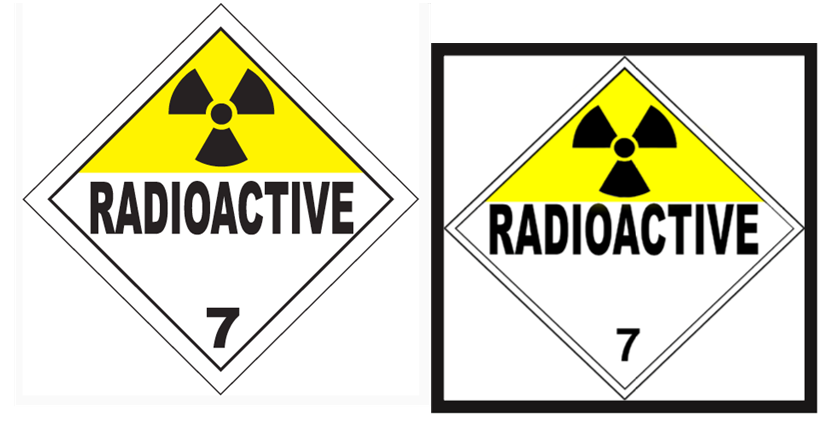
Example of Placards Indicating Radioactive Contents in Vehicles (Source of graphics above:
Radioactive Materials, Transportation and Incident Response, (PDF - 8 MB) FEMA, DOE/TEPP, May 2010, and DOE/TEPP/MERRTT training course: Hazard Recognition) (PDF - 705 KB)
- Where placards are displayed on transportation vehicles
- When required, placards must be in plain view and displayed on all four sides of the transport vehicle as shown above
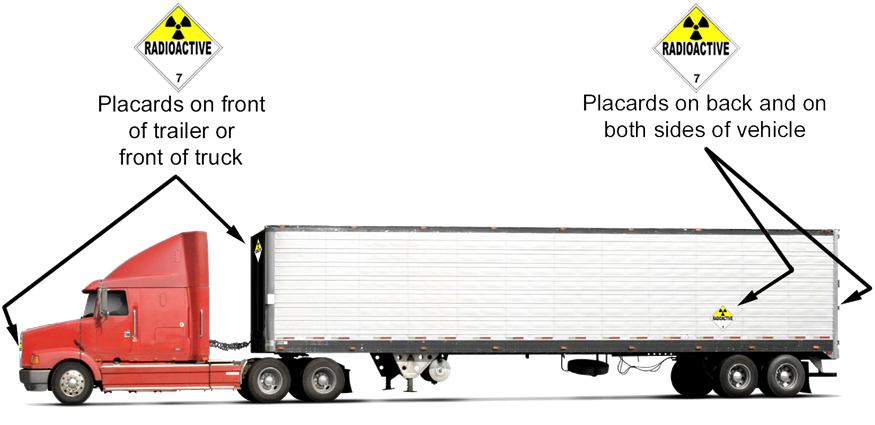
Where Placards Are Placed on Trucks (Source of graphic above: DOE/TEPP/MERRTT)
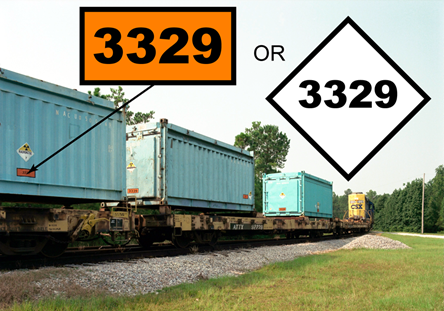
Placard and UN ID on Rail Car (Source of train car graphic above: DOT/TEPP/MERRT)
- In the photo above
- Placard is the square (on point) sign with trefoil on yellow background on top.
- Below the placard is the orange sign indicating UN ID designation 3329 which means “Radioactive material, Type B (M) package, fissile”
- When required, placards must be in plain view and displayed on all four sides of the transport vehicle as shown above
More about UN ID numbers
- United Nations UN ID number (four digits)
- Often shown adjacent to the placard on an orange panel or on a plain white square-on-point configuration that is the same size as a placard.
- One example is shown above
- Below the placard is the orange sign indicating UN ID designation 3329 which means “Radioactive material, Type B (M) package, fissile”
- More about UN ID (UN number) / US DOT number
- IU Number (or UN ID) is a 4 digit number.
- It identifies hazardous substances, and articles (such as explosives, flammable liquids, radioactive materials, toxic substances, etc.) in the framework of international transport.
- Some hazardous substances have their own UN numbers (e.g. acrylamide has UN2074), while sometimes groups of chemicals or products with similar properties receive a common UN number (e.g. flammable liquids, not otherwise specified, have UN1993).
- A chemical in its solid state may receive a different UN number than the liquid phase if their hazardous properties differ significantly; substances with different levels of purity (or concentration in solution) may also receive different UN numbers.
- UN numbers range from UN0001 to about UN3518 and are assigned by the United Nations Committee of Experts on the Transport of Dangerous Goods.
- NA numbers (North America), also known as DOT numbers are issued by the United States Department of Transportation and are identical to UN numbers, except that some substances without a UN number may have an NA number. These additional NA numbers use the range NA8000 - NA9999.
- The 4 digit UN number (UN ID) noted above is not the same as the 1 digit UN Hazard Identifier (although each 4 digit UN number typically has a Hazard Identifier associated with it
- There are 9 classes of Hazard Identifiers and some of them have subdivisions associated with them.
- UN Hazard Identifier 7 indicates Radioactive Materials; it has no associated subdivision.
- IU Number (or UN ID) is a 4 digit number.
- Useful resources for understanding UN ID and Hazard Identifiers and US DOT numbers
Limits on Amount of Radioactivity for Shipping
- Limits for Packages in Non-Exclusive-Use Vehicles
- 200 mrem/hr (2 mSv/hr) at external surface of package
- Individual packages cannot exceed 10 mrem/hr (0.1 mSv/hr) at 1 meter: transport index = 10.
- Non-exclusive use means normal conditions for a common carrier using open or closed vehicles that may be carrying other non-radioactive material.
- Limits for Exclusive-Use Vehicles
- 2 mrem/hr (0.02 mSv/hr) in cabin; 200 mrem/hr (2 mSv/hr) on surface of vehicle
- 10 mrem/hr (0.1 mSv/hr) maximum at 2 meters
- Under certain conditions, individual packages on exclusive-use vehicles can have readings up to 1 rem/hr (10 mSv/hr) on contact with package surface. Exposure levels will be significantly higher if package is breached.
- “Exclusive use” means a single shipper transports the material and all initial, intermediate, and final loading and unloading are carried out in accordance with the direction of the shipper or receiver.
- Drivers of exclusive shipments are required to have specific written instructions for the shipment. These instructions must be included with the shipping papers.
- Note: To determine if a shipment is being transported under the exclusive use provisions, look at the shipping papers, ask the driver, and/or contact the shipper.
- Packages in exclusive use vehicles may have radiation levels up to 1,000 mrem/hour on their exterior surface provided that: a) the shipment is made in a Closed Transport Vehicle; b) the package is secured within the vehicle so that its position remains fixed during transportation, and c) there are no loading or unloading operations between the beginning and end of the transportation.
- Closed Transport Vehicle means a transport vehicle or conveyance equipped with a securely attached exterior enclosure that, during normal transportation, restricts the access of unauthorized persons to the cargo space.
Selected References about Transporting Radioactive Materials
- Emergency Response Guidebook (ERG), 2020 (USDOT/Pipeline and Hazardous Materials Safety Administration)
- Provides first responders with a go-to manual to help deal with hazmat transportation accidents (including radiation) during the critical first 30 minutes.
- ERG Handbook in PDF format (PDF - 3.33 MB)
- Hazard Classification System (9 classes)
- Radioactive materials (Class 7), see page 6
- Table of Hazard Markings, Labels and Placards
- Graphics library of hazardous material types: see pages 7-9
- Radiation placards numbers: see page 9
- Hazard Identification (ID) Numbers:
- Library of ID numbers: see pages 18-21
- Radiation hazard numbers: 70,768, 78; see page 21
- Radioactive Materials Information library
- Radioactive Materials: see pages 258-269
- ERG Mobile App is available
- Supplementary app: CBRN
- App developed in partnership between the Vermont Department of Health, Saint Michael's College Department of Public Safety and Saint Michael's College Fire and Rescue.
- Designed to supplement the US DOT Emergency Response Guide (ERG), but not replace it. Full ERG download
- Includes excellent resources for initial first responders on scene who suspect a potential Radiological /Nuclear emergency incident
- Link to initial activities video listed in the "Table of Contents" as "Radiological and Nuclear" (video 2:09)
- Links to R/N training videos and documents listed in the "Table of Contents" page on page labeled "Training Videos/Docs"
- Downloadable in Apple store with search for "CBRN"
- Hazard Classification System (9 classes)
- Radioactive Materials, Transportation and Incident Response (PDF - 8 MB) (FEMA, DOE/TEPP, May 2010)
- Transportation Emergency Preparedness Program / Emergency Responder Radioactive Material Quick Reference Sheet (PDF - 461 KB) (DOE/TEPP)
- Radioactive Material Shipping Packages (YouTube - 5:48 minutes) (DOE/TEPP/MERRTT)

- Transportation of Radioactive Materials, Unit 5 (PDF - 242 KB) (NRC) (This is part of a radiation curriculum for educators.)
- Assessing Package Integrity (PDF - 557 KB) (DOE/TEPP/MERRTT)
- Transportation of Radioactive Materials, (PDF - 371 KB) (Reactor Concepts Manual, USNRC Technical Training Center, Chapter 11. This is an older document, but it has useful background material.)
- UN Regulations and Recommendations on the Transport of Dangerous Goods, Model Regulations, July 2015
- Complex US regulations regarding loading, transport and storage of hazardous materials are found in the US Code 49 CFR
- Transporting Hazardous Materials (OSHA web site aggregating transportation of hazardous materials information from many sources)
- Hazardous Materials Classes
- Hazardous Material of CAS/UN/NA-Number Look up Tool (49 CFR)
- Radioactive Material (PDF - 2.49 MB) (US DOT Pipeline and Hazardous Materials Safety Administration, Dec 2008) This is a review of regulations, and it has many useful graphics and explanations.
- How to Handle Radioactive Materials Packages, a Guide for Cargo Handlers (PDF - 948 KB) (DOT, 2006)
- See also:

